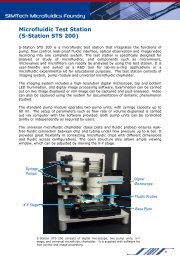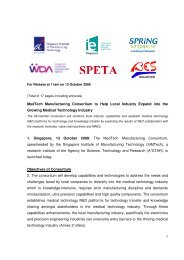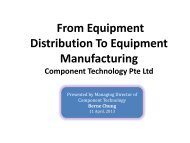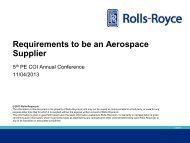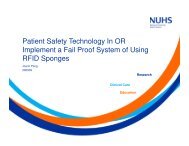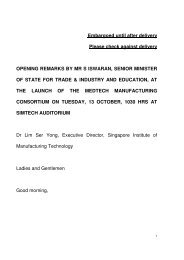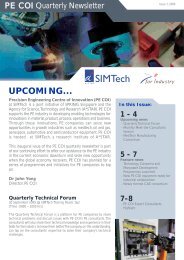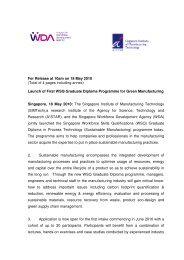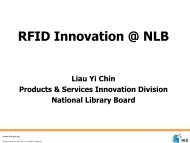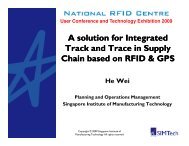Carbon Footprinting - Singapore Institute of Manufacturing Technology
Carbon Footprinting - Singapore Institute of Manufacturing Technology
Carbon Footprinting - Singapore Institute of Manufacturing Technology
- No tags were found...
Create successful ePaper yourself
Turn your PDF publications into a flip-book with our unique Google optimized e-Paper software.
MAKING IT GREENAMF’10
I’d just like to say aBIG THANKYOU TOSIMTech…for hosting this event
And a few words aboutWHAT I’VELEARNEDTODAY
And a few words aboutWHAT I’VELEARNEDTODAY… change is happening in<strong>Singapore</strong> and the region
And a few words aboutWHAT I’VELEARNEDTODAY… change is happening in<strong>Singapore</strong> and the region… <strong>Singapore</strong> is starting tolead the way
And a few words aboutWHAT I’VELEARNEDTODAY… change is happening in<strong>Singapore</strong> and the region… <strong>Singapore</strong> is starting tolead the way in some areas… and it’s happening withgovernment, researchinstitutes and industryworking together
We’ve heard aboutTWO GREATEXAMPLES
1stthe announcementthis morning from&<strong>of</strong> a new WSQprogramme in SUSTAINABLEMANUFACTURING
2ndwe’ve heardabout the excitings<strong>of</strong>t launch <strong>of</strong> thedeveloped bySINGAPORECARBONLABELworking with…
The bottom line isCHANGE ISHAPPENING RIGHTHERE INSINGAPORE
WHAT WE’REGOING TOCOVERTODAY
I’m going to talk about
What is a carbon footprint?
What is a carbon footprint?How to measure it?
What is a carbon footprint?How to measure it?The UK experience.
In particular, whatinterests me the most:
In particular, whatinterests me the most:How businesses can:
In particular, whatinterests me the most:How businesses can:- Reduce costs
In particular, whatinterests me the most:How businesses can:- Reduce costs- Reduce carbon
In particular, whatinterests me the most:How businesses can:- Reduce costs- Reduce carbon- Grow revenues
For those <strong>of</strong> you whodon’t know meI’m Dean StantonI work with
Working forthe past 6years withM&S…
• A S$500m, 100 point eco-plan formaking M&S a sustainable retailer• Sustainable with a capital “S”Plan A is…• About strong commitments over 5 yearsin 5 areas:• Climate change – eliminatingCO2 emissions and other GHGs• Waste – zero landfill• Raw materials – usingsustainable, re-usable, natural,recyclable materials• Fair partner – making adifference to livelihoods &communities locally and globally• Health – helping customers andemployees live a healthier lifestyle
… and forthe past 2years withH&M
Developingvaluablelow carbonbusinessesfor the UK’s
SO…
What is a carbon footprint?
“What is a carbon footprint?Every product or service we make,deliver, buy and consume has a carbonfootprint that we can measure.
What is a carbon footprint?“Every product or service we make,deliver, buy and consume has a carbonfootprint that we can measure.This carbon footprint represents the totalamount <strong>of</strong> greenhouse gases (in tonnes<strong>of</strong> CO2 equivalent) produced during thelife cycle <strong>of</strong> the product or service, fromproduction to final disposal.”
What does it look like?Example:Can <strong>of</strong> cola
What does it look like?Example:Can <strong>of</strong> colaSource: The <strong>Carbon</strong> Trust
What does it look like?Example:Can <strong>of</strong> colaSource: The <strong>Carbon</strong> Trust
How to measure it? The ISO wayDraft StandardISO 14067
How to measure it? The ISO wayDraft StandardISO 14067A precise measure <strong>of</strong> a carbonfootprint:“is a powerful tool for decarbonizingthe productsupply chain”Klaus RadunskyChairman ISO 14067 Working Group
How to measure it? The ISO wayDraft Standard ISO 14067A new standard for product carbon footprints.Builds on existing ISO standards for:• Life cycle assessments (ISO 14040/44); and• Environmental labels and declarations (ISO 14025)Planned to be published by March 2011 although this maybe revised.
How to measure it? The BSI wayPAS 2050Development commenced inJune 2007, when The <strong>Carbon</strong>Trust and DEFRA approachedBSI to develop a publiclyavailable specification (PAS).
The genesis <strong>of</strong> PAS 2050Specification+ =2006 2006/7Guide
Sample outputs: Boots
A word about measurement• Applies to all goods and services with considerationgiven to how and whether it may need customising forspecific product groups, e.g. food, buildings,electronics, etc.• Considers all lifecycle stages along the supply/valuechain <strong>of</strong> a product (goods and/or services), i.e. fromraw materials to end <strong>of</strong> life• Includes the six GHGs identified under the Kyotoprotocol• Could be used by all sizes and types <strong>of</strong> organisations
REAL WORLDRESULTSSOME CASE STUDIES
REAL WORLDRESULTSPEPSICO & WALKER’SCRISPS
PEPSICO &WALKER’S CRISPS
BACKGROUNDWALKER’S CRISPS• PepsiCo is the parent company <strong>of</strong> Walker’s• The Walker’s business includes the largestcrisp manufacturing plant in the world• Potatoes are 100% UK sourced, so much <strong>of</strong> thesupply chain is contained within the UK• The first company in 2006 to workwith the <strong>Carbon</strong> Trust to measure aproduct carbon footprint• The first company to be measuredunder PAS 2050• The first product to carry a productcarbon label: Walker’s Cheese andOnion Crisps
ACHIEVEMENTSWALKER’S CRISPS• Only using British potatoes, to cutdown food miles• Improving production efficiency toreduce gas by 11%, electricity by 22%and water consumption by over 700million litres in one factory alone.• Making a 4.5% reduction in emissionsassociated with producing crisppackets• Recycling over 90% <strong>of</strong> waste• Reducing the weight <strong>of</strong> packaging• Running delivery lorries on biodieseland using fuel efficient drivingSaving 4,800tonnes <strong>of</strong> CO 2Reducingcarbonfootprint by7%Saving close toS$1m annually
OTHER LEARNINGSWALKER’S CRISPSWalkers is also a case study in:• The power <strong>of</strong> effective supplierengagement to reduce carbonemissions• The importance <strong>of</strong> making publiccommitments to drive real actionand results…and provides evidence that carbonfootprinting and labelling matter toconsumers.
REAL WORLDRESULTSCONTINTENTALCLOTHING
BACKGROUNDCONTINENTALCLOTHING• Established in 1994,Continental Clothing is a B2Bwholesaler <strong>of</strong> blank printablet-shirts, polo shirts andsweatshirts for corporate,leisure and promotional wear.• Customers are primarily in themusic and advertisingindustries.• Continental Clothing employs45 people and operates in theUK, US and Germany.
SUPPLY CHAINCONTINENTALCLOTHINGContinental’s supply chains vary by product line:• Some products are manufactured using a verticallyintegratedsupply chain in which certified organiccotton farming, spinning, dying and clothing productionall take place in wholly-owned sites.• Others are produced using a more traditional,disaggregated supply chain.
OUTCOMESCONTINENTALCLOTHING
CONCLUSIONS&NEXT STEPS
dean@brandgreen.co.uk+65 9445 8880



